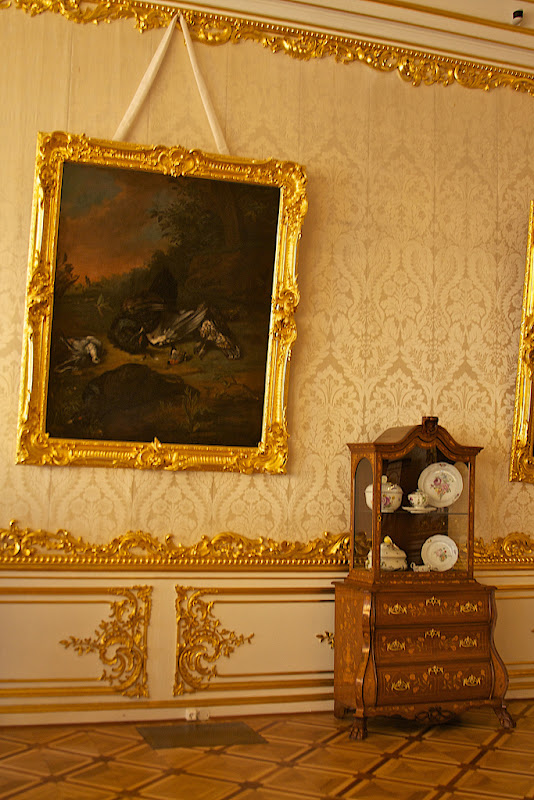The residence originated in 1717, when Catherine I of Russia engaged the German architect Johann-Friedrich Braunstein to construct a summer palace for her pleasure. In 1733, Empress Anna commissioned Mikhail Zemtsov and Andrei Kvasov to expand the Catherine Palace. Empress Elizabeth, however, found her mother's residence outdated and incommodious and in May 1752 asked her court architect Bartolomeo Rastrelli to demolish the old structure and replace it with a much grander edifice in a flamboyant Rococo style. Construction lasted for four years and on 30 July 1756 the architect presented the brand-new 325-meter-long palace to the Empress, her dazed courtiers and stupefied foreign ambassadors.
During Elizabeth's lifetime, the palace was famed for its lavish exterior. More than 100 kilograms of gold were used to gild the sophisticated stucco façade and numerous statues erected on the roof. It was even rumoured that the palace's roof was constructed entirely of gold. In front of the palace a great formal garden was laid out. It centres on the azure-and-white Hermitage Pavilion near the lake, designed by Zemtsov in 1744, overhauled by Rastrelli in 1749 and formerly crowned by a grand gilded sculpture representing The Rape of Persephone. The interior of the pavilion featured dining tables with dumbwaiter mechanisms. The grand entrance to the palace is flanked by two massive "circumferences", also in the Rococo style. A delicate iron-cast grille separates the complex from the town of Tsarskoe Selo.
Although the palace is popularly associated with Catherine the Great, she actually regarded its "whipped cream" architecture as old-fashioned. When she ascended the throne, a number of statues in the park were being covered with gold, in accordance with the last wish of Empress Elizabeth, yet the new monarch had all the works suspended upon being informed about the expense. In her memoirs she censured the reckless extravagance of her predecessor:
-
- "The palace was then being built, but it was the work of Penelope: what was done today, was destroyed tomorrow. That house has been pulled down six times to the foundation, then built up again till it was brought to its present state. The sum of a million six hundred thousand rubles was spent on the construction. Accounts exist to prove it; but besides this sum the Empress spent much money out of her own pocket on it, without ever counting".
In order to gratify her passion for antique and Neoclassical art, Catherine employed the Scottish architect Charles Cameron who not only refurbished the interior of one wing in the Neo-Palladian style then in vogue, but also constructed the personal apartments of the Empress, a rather modest Greek Revival structure known as the Agate Rooms and situated to the left from the grand palace. Noted for their elaborate jasper decor, the rooms were designed so as to be connected to the Hanging Gardens, the Cold Baths, and the Cameron Gallery (still housing a collection of bronze statuary) - three Neoclassical edifices constructed to Cameron's designs. According to Catherine's wishes, many remarkable structures were erected for her amusement in the Catherine Park. These include the Dutch Admiralty, Creaking Pagoda, Chesme Column, Rumyantsev Obelisk, and Marble Bridge.
Upon Catherine's death in 1796, the palace was abandoned in favour of the Pavlovsk Palace. Subsequent monarchs preferred to reside in the nearby Alexander Palace and, with only two exceptions, refrained from making new additions to the Catherine Palace, regarding it as a splendid monument to Elizabeth's wealth and Catherine II's glory. In 1817, Alexander I engaged Vasily Stasov to refurbish some interiors of his grandmother's residence in the Empire style. Twenty years later, the magnificent Stasov Staircase was constructed to replace the old circular staircase leading to the Palace Chapel. Unfortunately, most of Stasov's interiors - specifically those dating from the reign of Nicholas I - have not been restored after the destruction caused by the Germans during World War Two.
When the German forces retreated after the siege of Leningrad, they had the residence intentionally destroyed,[1] leaving only the hollow shell of the palace behind. Prior to World War II, the Russian archivists managed to document a fair amount of the contents, which proved of great importance in reconstructing the palace. Although the largest part of the reconstruction was completed in time for the Tercentenary of St Petersburg in 2003, much work is still required to restore the palace to its former glory. In order to attract funds, the administration of the palace has leased the Grand Hall to such high-profile events as Elton John's concert for the elite audience in 2001 and the 2005 exclusive party which featured the likes of Bill Clinton, Tina Turner, Whitney Houston, Naomi Campbell, and Sting.




































































